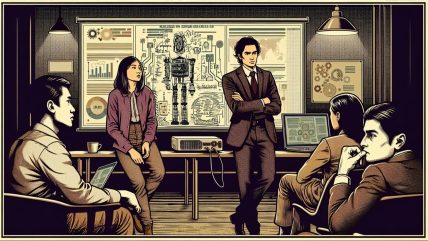
In a few short years, we are told, AI will transform the world of work beyond all recognition. A new wave of automation will dispatch accountants, news writers and call centre workers to the same heap of irrelevance as the ice cutter, the switchboard operator and the print worker. The robots won’t rule the world, to be sure, but they’ll certainly annex most of the repetitive but necessary tasks too complex for machine learning algorithms but too dull to enliven the average human mind.
The only question left, then, is when that metamorphosis will begin. Recent data suggests it might be a while yet. Managers consistently report that the uptake of AI tools in the workplace remains low – sometimes as low as 26%. Some point to a persistent streak of Luddism as the culprit for this dogged lack of enthusiasm for the hottest new technology on the block. Indeed, some employers have decided to force the issue by rolling out costly skills programmes to bounce their staff into getting to grips with newly deployed AI platforms.
Managers would be better advised to consider the design and deployment of the AI tools themselves. They should begin by evaluating how these models are being practically deployed. All too often, firms leave product trials in the hands of their IT departments, without any input from their wider workforces. While an IT expert can spot a bug, they might fail to identify how complex the tech will be to operate for less tech-savvy colleagues.
Instead, employees of all ages and across all departments must be involved in trialling new AI products and services, with the opportunity to offer their honest feedback. What’s more, a standardised usability rating should be applied to such tools based on this feedback.
AI uptake can be boosted after office feedback
How employees interact with these tools at the interface level is vital to understanding why someone may or may not choose to integrate AI into their workflow. This is an area where there’s been remarkably little creativity from founders and startups. Indeed, the vast majority of AI tools still rely on a chatbot bolted onto a service or product.
Chatbots are certainly a great way for humans to interface with an AI in some situations. Learning scenarios, such as employee onboarding, where the user might have a low level of initial knowledge and a high number of questions, can be served well by these miniature machine intelligences. But there are also plenty of other tasks and situations in a corporate context where other UX structures may be preferable for the employee and will thereby increase the likelihood of adoption of the specific AI tool.
Data-heavy tasks for example, where the employee is required to analyse large amounts of numerical information, would be far better served by a dashboard, allowing the user to view, filter, and manipulate the data more effectively. In this case, an AI-powered chatbot may be seen as actually slowing the employee down, forcing them to translate numerical and technical solutions into verbal communication.
There’s also a host of possibilities for more direct manipulation that could greatly increase the likelihood of take-up in a corporate setting. Tools that creatively integrate resizing, dragging, pinch-to-zoom, and other features that we take for granted on smartphones, could greatly enhance employee experience and free them from the often-frustrating experience of communicating solely through a chatbot. Tasks like workflow management, data entry, and surveys could all be upended by integrating more direct manipulation into the UX.
The answer, therefore, to lagging employee uptake of AI tools is not to inflict more dull upskilling courses on the workforce. Rather, management needs to take a step back and think more deeply about just how they roll out these new technologies, and not just rely on IT departments to trial products without input from the wider workforce. Corporate leaders must also be prepared to take risks and get creative with what kinds of AI products they deploy. Ultimately, there are many more options available than the ubiquitous chatbot. It’s time corporations started making use of them.
Dan Thomson is the founder and CEO of Sensay.






